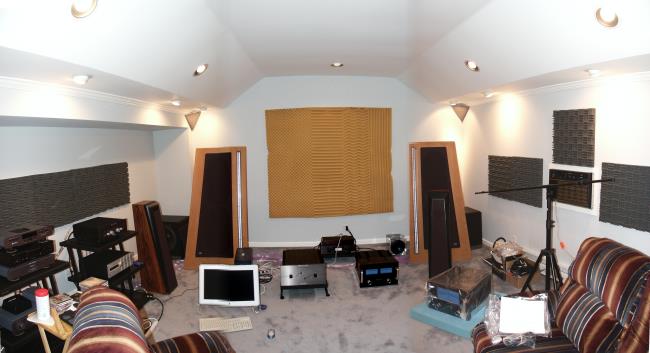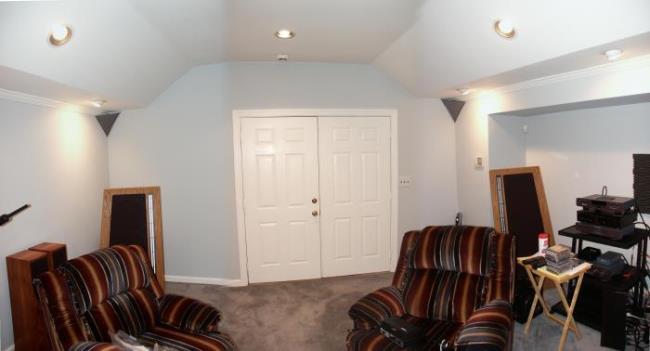Introduction
I am sure that just about every Secrets reader has
a home theater or hi-fi system of some sort. Expensive, modest, or just
basic . . . but something.
After getting all that stuff, a DVD player,
receiver, extra power amplifiers, speakers, cables, maybe a projector
and screen, you thought you were done, right? Well, I thought I was
done, until I realized that in spite of having very good equipment in
our test lab and other rooms, something didn't sound quite right. It
wasn't as focused as I wanted. Maybe a little boomy, even with servo-feedback
subwoofers. Some of the sound was coming from the walls near the
speakers, rather than mainly from the speakers.
So, what was the problem? Lack of acoustical room
treatment.
Recordings are made in rooms that have reflective
surfaces, more or less. Some have lots of absorption panels, some not so
many. But, there is always at least a little reflection.
When you listen to these recordings in your own
home theater or audio room, living room, den, whatever, you pile the
reflections that the recording has onto the reflections of the sound in
your room after it comes out of the speakers.
This does two basic things. One is the high
frequencies are bounced around so that any one sound arrives at your
ears several times very close together. This mushes up the detail.
Secondly, the room serves to accentuate the bass, making it boomy, like
being inside a big bass drum.
Neither of these room effects are desirable to high
fidelity sound reproduction.
So, what is the solution? Apply acoustical room
treatment.
The Available Measures
Anechoic chambers are the extreme end of room
treatments, and are really only useful for testing the absolute
frequency response of speakers. They are not for listening to music,
because we are not used to having no sound reflections. In fact, it is
downright uncomfortable to be in an anechoic chamber.
What we want in our own home theaters and audio
rooms is not anechoic, but rather, a controlled amount of
absorption and reflection (diffusion), and that is what are going to
talk about in this series of articles. Some of the commercial solutions
are expensive, and some are not expensive. You can also make your own,
and we will cover those too. The goal of this article is not to convince
you to buy any particular brand or product, but to just give you our
experiences in treating the Secrets lab.
There are lots and lots of products out there to
help you make your home theater sound great. Basically, they fall into
two categories, absorption and diffusion.
Absorption products remove some of the sound
that hits them by absorbing it and converting it to heat. They include
such things as foam panels, fiberglass panels, and bass traps. Foam
panels have different surface designs. Some have pyramids or other
shaped protrusions. This increases the surface area and deflects
unabsorbed sound from one protrusion to another, instead of reflecting
the sound back into the room. Depending on the depth of the panels, it
will absorb sound of different frequencies to different degrees. Thicker
panels absorb more sound.
Usually, the panels are more effective at higher
frequencies than lower ones, so you need additional absorption devices
to handle the low frequencies. This is where the bass trap comes in.
Bass traps usually go in the corners, where bass tends to get amplified,
like a megaphone. They can be just thick foam triangles, or cylindrical
units.
The amount of absorption by room treatment panels
can be measured and specified. Some of the terms used include the
coefficient of absorption and sabines. The coefficient of absorption
states how absorptive the product is, with the higher the coefficient,
the more absorptive. The number represents the percentage of sound that
is absorbed. A standard of 500 Hz is often used, since the
coefficient changes with the frequency. A sheet rock wall might have a
coefficient of 0.02 (i.e., it absorbs 2% and reflects 98%), while a 2" thick absorption panel could be 0.6 at
500 Hz and 0.1 at 100 Hz . A sabine is the coefficient of absorption
multiplied by the square foot of surface. (One square foot of material
that absorbs 100% of the sound that hits it represents 1 sabine.) So, with the sheet rock wall
8' high by 12 feet wide, that is 96 square feet, multiplied times 0.02
equals 1.92 sabines. A single 2" thick 2'x4' absorption panel would be
somewhere around 5 sabines.
The idea is to reduce the reverberation time in the
room, and there is a formula which states that the reverberation time in
seconds is equal to 0.05 times the volume of the room in cubic feet
divided by the total number of sabines in the room.
If you put absorption panels on all the room
surfaces, excluding the floor of course, the room would probably be
pretty dead, meaning that there are very few sound reflections. This
is unpleasant. But, leaving a wall or ceiling untreated still results in
that smearing of sound. So, this is where you use diffusors.
These reflect the sound, rather than absorbing it.
Diffusors are usually in the shape of panels with
mathematically designed surfaces that bounce the sound around and
release it in a random fashion. This lets the room remain alive, but you
don't hear distinct echoes. The flutter echo, clap echo, or slap echo is
one test that is used to determine if your room has a problem. You just
clap your hands together and listen for the echoes. If there is a
problem, you will hear the clap reverberating.
Our test lab had boomy bass, unfocused sound,
smeared sound, and plenty of clap echo. So, I knew I had to do
something. Not just because it is a test facility, but, I wanted it to
sound good too, for when I sat down and just listened to music.
Treating the Secrets Lab
Our main test lab is about 18'x20' with 6'-8'
ceilings at the soffits, and a 10' ceiling in the center of the room.
I looked around at many different products. There
are lots of them out there, including those from SONEX, RPG Acoustics,
Auralex, Tecnifoam, Echobusters, Acoustic Sciences, and others.
I settled on
SONEX foam
panels and bass traps, and RPG
diffusors.
The question was which surfaces to treat. After
getting some suggestions - each of the companies offers all the advice
you want - I decided to treat all the walls with SONEX foam absorption
panels, covering most, but not all of the surface, and treat the ceiling
with RPG diffusors.
So, after settling on that, I had to decide on
which model of panel and diffusor to use.
SONEX carries several types of foam panels,
including various thickness and surface designs. I settled on what they
call SONEXclassic. They also offer SONEXone, SONEXsuper, SONEXmini, and
SONEXvalueline. They are different prices and are for a variety of
applications.
I purchased the SONEXclassic, in white, 2" in
thickness. I chose
white because I did not want the lab to look like a dungeon. It is like
photographic darkrooms. Most of the darkrooms I have seen are painted
black. That is not necessary if you control the light in the
room.
I have several lighting systems in our lab. One nice thing about the white, is that it only comes in
Melamine, which is fireproof, compared to the polyurethane panels in the
other colors. Here is a picture of the front of the room, before
treatment, where the main speakers are located.

You can see that there is equipment all over the
place in this room, one of the hazards of being the editor of an A/V
publication. The room was just begging for proper treatment, and I am
surprised it took me this long to realize that.
This photo a panoramic one, having been stitched
together from four separate photos using some panorama software, so
there is distortion in the room lines. But, you can see the basic room
layout. The left side has two soffits, while the right side has only
one. I had some basic wall treatments, including some SONEX foam panels
on the side walls, and I used an egg shell mattress pad for the front
main wall. It worked OK, but as I discovered, not nearly well enough.
There was no treatment on the ceiling, except for a couple of corner
foam triangles, and this resulted in significant clap echo.
There are no windows in this room, and only one
opening on the right side where an air conditioner sits.
You can see the three lighting systems, each on
solid state rheostat controls. One is on the angled part of the ceiling,
one underneath the first soffit, and a third in the two corners at the
ceiling line. I use the three systems to obtain a particular mood for
listening. I love the two corner lights the best, and they will be used
as bias lights once our projection screen is installed, as they will be
behind the screen. I have all lights on when I do bench testing, as I am
getting older, and every watt counts when I want to see all those
details in the products.
I also purchased some SONEX bass traps, which are
polyurethane, 12"x12"x24". Each bass trap has 12 sabines
of absorption below 500 Hz, which is six times what the 8'x12' sheet
rock wall has.
I tested polyurethane in the bass traps
by setting a scrap piece to the flame on a stove. It smoldered a bit,
then went out. It did not flame at all, due to chemical treatment at the SONEX factory.
Here is a photo of the rear wall, where the doors
are located. Again, it is a stitched panorama, so ignore the crooked
room lines.

I have two corner foam triangles there, like in the
corners of the front wall. Basically, I hereby confess that this is
pretty pathetic treatment. I thought that I had done enough, but now
realize that it was not nearly what I should have had in there. Look at
those dipolar ribbons in the corner. How stupid I was to not put corner
treatments behind them.
Anyway, I had to decide on how much of the room
surface to cover, and then calculate the number of panels to buy,
knowing that the foam wall absorption panels are 2'x4' and the ceiling
diffusor panels are 2'x2'. The bass trap calculation was based on its
1'x1'x2' dimension.
I purchased two packages of SONEX wall panels, with
eight in each package ($213 per package), and five packages of SONEX
bass traps, with two to a package ($54 per package). I ordered the traps
in beige. I also purchased six packages of RPG Skyline LP diffusors,
with two to a package ($160 per package). As it turned out, I needed a
few more bass traps and diffusors, and simply ordered them later.
Click Here to Go to Part II.